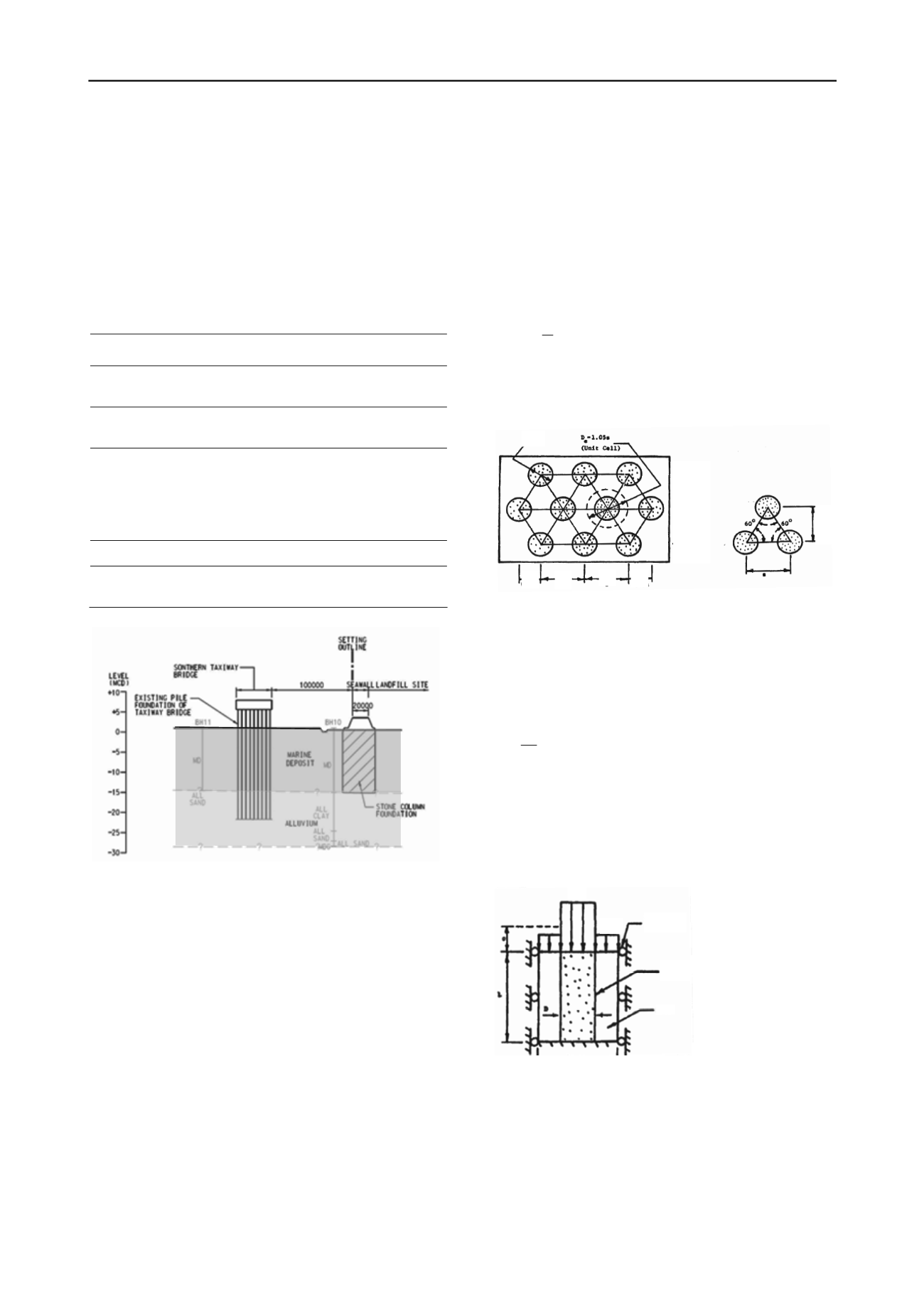
2930
Proceedings of the 18
th
International Conference on Soil Mechanics and Geotechnical Engineering, Paris 2013
2 SITE GEOLOGY
The superficial deposits within the study area comprise marine
deposit (MD) of the Holocene age overlying a layer of alluvium
of the Pleistocene age. Underlying the alluvium is the saprolitic
soil consisting of completely decomposed granite (CDG). The
solid geology comprises coarse-grained granite of Jurassic-
Cretaceous age. Fill material has been subsequently placed over
the marine soft clay deposit by the landfilling activities.
Figure 3 shows the typical geological section of the site. Table 1
shows the typical thickness and constituentcy of the strata.
Table 1. Summary of Geological Strata
Strata
Thickness
(m)
Constituent
Fill
4 to 7
C&D waste comprised disturbed mud, silty
clayey, sand, concrete, bricks, wood, steel
Marine
Mud
13 to 28
Very soft to soft, dark grey, clay to silty
clay with occasional shell fragments.
Alluvium
0 to 58
average
30
Soft to stiff, mottled yellowish brown light
grey to brown, silty CLAY, CLAY/SILT
Medium dense to very dense, yellowish
brown to yellowish grey, silty fine to
coarse SAND.
CDG
0 to 10
Sandy silty to silty fine to coarse SAND
Bedrock
-
Moderately strong to strong, moderately
to slightly decomposed granite.
Figure 3. Typical Geological Section
3 DESIGN OF THE SEAWALL
The purpose of the seawall is to contain the dumped surfical
clayey and other materials from spreading towards the STB, to
prevent the further generation of the mudwaves that would
impact the STB and to provide a stable and secure edge to the
landfill. Since the founding material of the seawall is very soft
to soft marine clay, ground treatment, by means of stone
columns, are required to strength the foundation of the seawall
in order to ensure the stability. It also improved the shear
strength and stiffness of the soil mass to minimise the influence
of the lateral load induced by the landfill soil mass that could
possibly cause disturbance to the STB.
3.1 Principle of Ground Improvement by Stone Column
Stone column construction involves the partial replacement of
the very soft subsurface soils with compacted, vertical columns
of stone that completely penetrates the weak strata. The stronger
and stiffer material will attract more stresses (i.e. the stone
columns) and therefore the composite ground comprising stone
columns and soft clay (Barksdale, R.D. & Bachus R.C. 1983)
will be stronger and stiffer and capable of carrying a larger load
originating from the landfill behind,preventing the formation of
mudwaves. The stone columns will also act as vertical drains
within the soft clay facilitating the rapid dissipation of the
excess pore pressures allowing it to quickly consolidate and
gain in strength, thus further increasing the stiffness of the
composite soil mass over time.
The strength of the composite ground depends on the
percentage of soil replaced by the stone columns, i.e. the
replacement ratio,
a
s
, as defined by (1) and illustrated in Figure 4.
2
1
s
DC a
s
(1)
D -
Diameter
of the compacted stone column
s
- Centre to centre spacing of stone columns
C
1
- Constant
depending
on stone column configuration pattern
D
s/2 s
s/2 s
Figure 4. Replacement Ratio of Stone Columns
For this project, a 1.2 m diameter stone column at 2.5 m c/c
spacing in a triangular pattern was adopted. The replacement
ratio
a
s
is about 21%. Since the stone aggregate columns are
much stiffer than the soft clay, the stresses will concentrate at
the stone columns. The distribution of the stresses can be
expressed by the stress concentrated factor
n
, defined as:
c
s
n
(2)
σ
s
= stress in the stone column
σ
c
= stress in the surrounding cohesive soil
The stresses over the soft soil and the stone column in term
of
a
s
from (1) and the average overall stress on the ground
surface,
σ,
is illustrated in a unit cell concept in Figure 5.
0.866s
σ
s
Fictitious
roller
σ
c
Stone
column
σ
s
- Stress in stone
Soil
σ
c
-Stress in clay
Figure 5. Ideal Unit Cell of Stone Column
σ
s =
n σ / [1+(n-1) a
s] =
μ
s
σ
(3)
σ
c =
σ / [1+(n-1) a
s] =
μ
c
σ
(4)
μ
s
=Ratio of stress in stone in relation to
σ
μ
c
= Ratio of stress in cohesive soil in relationto
σ
Using the expression of
μ
s
in (3), the stone column
foundation can be modeled as a composite material with the
average shear resistance expressed as:


